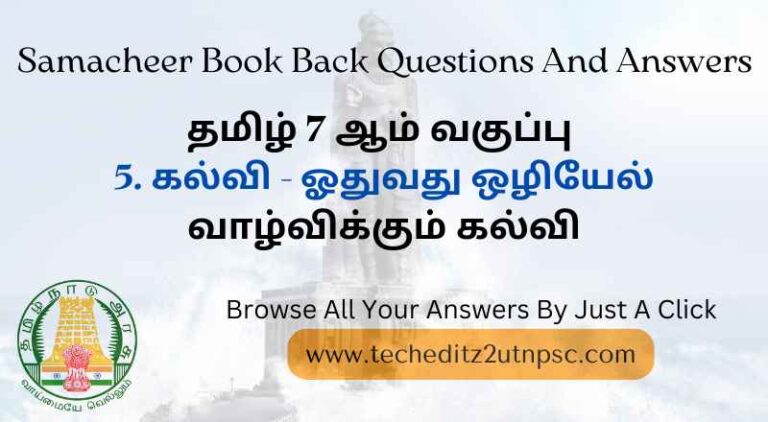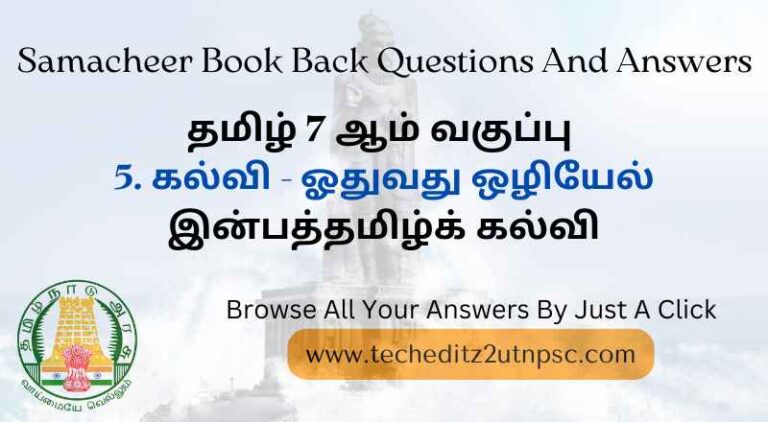support@techeditz2utnpsc.com | 8300-921-521

Light
Samacheer Book Back Questions And Answers For Science Standard 9 “Light“
I. Choose the correct answer:
1. A ray of light passes from one medium to another medium. Refraction takes place when angle of incidence is
(a) 0°
(b) 45°
(c) 90°
2. _____ is used as reflectors in torchlight.
(a) Concave mirror
(b) Plane mirror
(c) Convex mirror
3. We can create enlarged, virtual images with
(a) concave mirror
(b) plane mirror
(c) convex mirror
4. When the reflecting surface is curved outwards the mirror formed will be
(a) concave mirror
(b) convex mirror
(c) plane mirror
5. When a beam of white light passes through a prism it gets
(a) reflected
(b) only deviated
(c) deviated and dispersed
6. The speed of light is maximum in
(a) vacuum
(b) glass
(c) diamond
II. State whether true or false. If false, correct the statement:
1. The angle of deviation depends on the refractive index of the glass.
2. If a ray of light passes obliquely from one medium to another, it does not suffer any deviation.
3. The convex mirror always produces a virtual, diminished and erect image of the object.
4. When an object is at the centre of curvature of concave mirror the image formed will be virtual and erect.
5. The reason for brilliance of diamonds is total internal reflection of light.
Answers:
1. True
2. False (If a ray of light passes obliquely from one medium to another, it bends away from the normal)
3. True
4. False (When an object is at the centre of curvature of concave mirror the image formed will be real and inverted)
5. True
III. Fill in the blanks:
1. In going from a rarer to denser medium, the ray of light bends _____.
2. The mirror used in search light is _____.
3. The angle of deviation of light ray in a prism depends on the angle of _____.
4. The radius of curvature of a concave mirror whose focal length is 5cm is _____.
5. Large _____ mirrors are used to concentrate sunlight to produce heat in solar furnaces.
Answers:
1. towards the normal
2. concave
3. incidence
4. 10 cm
5. concave
IV. Match the following:
1. Ratio of height of image to height of object A. Concave mirror
2. Used in hairpin bends in mountains B. Total internal reflection
3. Coin inside water appearing slightly raised C. Magnification
4. Mirage D. Convex mirror
5. Used as Dentist’s mirror E. Refraction
Answers:
1. C
2. D
3. E
4. B
5. A
V. Assertion and reason type questions:
1. Assertion: For observing the traffic at a hairpin bend in mountain paths a plane mirror is preferred over convex mirror and concave mirror.
Reason: A convex mirror has a much larger field of view than a plane mirror or a concave mirror.
(a) If both assertion arid reason are true and reason is the correct explanation.
(b) If both assertion and reason are true and reason is not the correct explanation.
(c) If assertion is true but reason is false.
(d) If assertion is false but reason is true.
2. Assertion: Incident ray is directed towards the centre of curvature of spherical mirror. After reflection it retraces its path.
Reason: Angle of incidence (i) = Angle of reflection (r) = 0°.
(a) If both assertion arid reason are true and reason is the correct explanation.
(b) If both assertion and reason are true and reason is not the correct explanation.
(c) If assertion is true but reason is false.
(d) If assertion is false but reason is true.
Visit Our YouTube Channel For More Free Videos: Click Here


